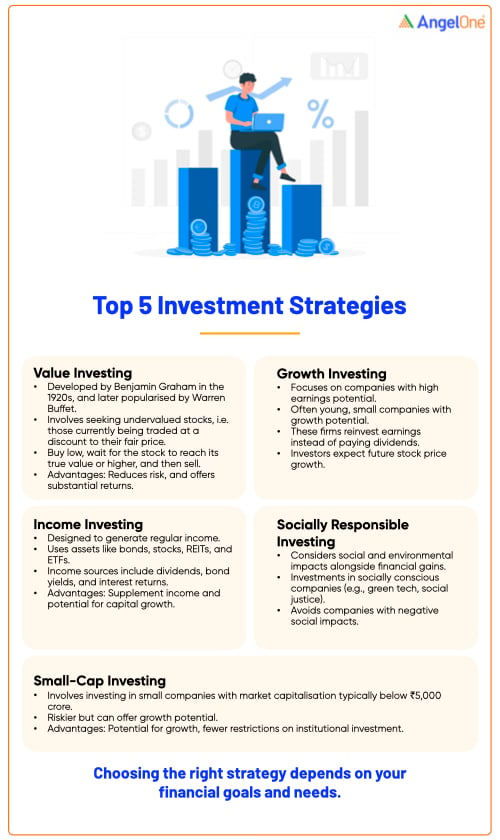Investment strategies are a set of postulates that help an investor achieve their investment and financial goals. The strategies are formulated based on the investor’s financial goals, risk tolerance, and target corpus. They are also formulated keeping the investor’s short-term goals and long-term goals in mind. These strategies can be curated by the investors themselves as well as the portfolio managers. The strategies need to be changed as and when required as per the circumstances, as a static strategy would not be feasible for every circumstance.
Different types of Investment Strategies
There are five different types of investment strategies:
- Value Investing
- Growth Investing
- Income Investing
- Socially Responsible Investing
- Small-Cap Investing
Value Investing
In the 1920s, Benjamin Graham developed a new method of investing in stocks called value investing, which was then made famous by Warren Buffet. To apply this strategy, one has to have a deep understanding of the stock market, as intensive research needs to be done.
In this strategy, the investors seek out stocks that are being traded that do not comply with their intrinsic value. There can be two cases under this- overvaluation and undervaluation.
Overvaluation refers to the situation when a stock’s trading price is higher than its intrinsic price, and undervaluation refers to the situation when the stock’s trading price is lower than its intrinsic price.
Investors purchase stocks when they are undervalued and sell them when the stocks reach their intrinsic value or higher. The investor has to be patient and wait till the price of the share rises, which maybe after a year or a few years.
The Advantages of Value Investing are:
Risk Minimisation- Usually, equity stocks are associated with high risks but, in the value investing method, the investors earmark the undervalued stocks and buy the potent shares on sale, thereby reducing the associated risks. They use margin of safety to reduce the risk. When these shares are sold at their intrinsic value or more, the investors receive substantial capital gains.
Substantial Returns- Due to the employment of the Margin of Safety, the returns are usually more than the average return in the long term.
Growth Investment
This strategy focuses on capital increment. Investors employing this strategy usually purchase stocks of companies that exhibit signs of above-average earnings increments relative to the market or their industry sector. Usually, these companies are young or small and emerging with high prospective returns, posing a higher risk.
Since these investors aim for capital appreciation, most growth-stock companies reinvest their earnings instead of paying their shareholders dividends.
If the company is assumed to have a higher potential of prospering, the stocks are traded at a high price/earnings (P/E) ratio, with the hopes of higher stock prices in the future as they are expected to perform better in the future. Usually, these companies hold patents or have access to technologies that put them ahead in the industry and ensure long term growth.
Income Investing
This strategy is focused on generating a regular stream of income. Usually, these portfolios include bonds, stocks, Real Estate Investment Trusts (REITs), exchange-traded funds (ETFs), and other such investment instruments that produce the highest passive annual income. The incomes are usually dividends, bond yields, and interest returns and involve minimal risks.
The Advantages of Income Investing are:
- A supplement of fixed income-It is an excellent way of earning extra income through one’s own assets to supplement their permanent income.
- Potential for growth of capital stock-In the long term, income investing strategies generate a potential for capital stock growth, eventually adding to one’s stock of wealth.

Socially Responsible Investing
In this investment strategy, investments are made, considering the social impact and the impact on the environment. Usually, investments are made in companies engaged in socially conscious activities such as social justice, alternative energies, clean technologies, environmental sustainability, etc. Investments are not made in companies that have a negative impact on society- like cigarette manufacturing companies, companies offering gambling services, etc.
The two primary goals of a socially responsible investing strategy are financial gain and social impact. One might not be able to achieve both together, as a socially conscious investment might not provide good returns, and an investment in a company with good returns might not have socially conscious principles. Hence, an investor needs to read through the fund’s brochure and determine the portfolio manager’s philosophies.
Small-Cap Investing
Small-cap investing strategy refers to investments made in stocks of small companies that have smaller market capitalisation, usually between $300 million and $2 billion. These investments are risky. The appeal of these stocks lies in the fact that, unlike large-cap stocks that have high prices due to being noticed by everyone, investors usually stay away from these stocks due to their riskiness and because there are restrictions on investment by institutional investors. Hence, an investor has to be well-versed with the stock market investment as these stocks are quite volatile and difficult to trade.
The Advantages of Small-Cap Investing are:
Growth Potential-Most large-cap companies were once small businesses. The new emerging companies bring new products and services to the market and sometimes even create entirely new markets. Since these companies have lower total value, they can grow in manners, unlike large-cap companies.
Restrictions on investment by mutual funds-Mutual Funds usually invest large amounts that small-cap companies cannot support. For the investment to impact the fund’s performance, the portfolio manager has to buy at least twenty per cent of the shares. The SEC or securities and exchange commission has introduced restrictions such that mutual funds cannot establish such prominent positions, giving individual investors an advantage to pick on promising companies before the institutional investors can.
Small-cap Value Index Funds- Small-cap value stocks are mostly unnoticed by the stock market investors and are undervalued, giving them larger returns. The best small-cap value index funds help get higher returns.
Hence, choosing a strategy for investment requires a thorough understanding of the investor’s goals and which suits his needs best.







